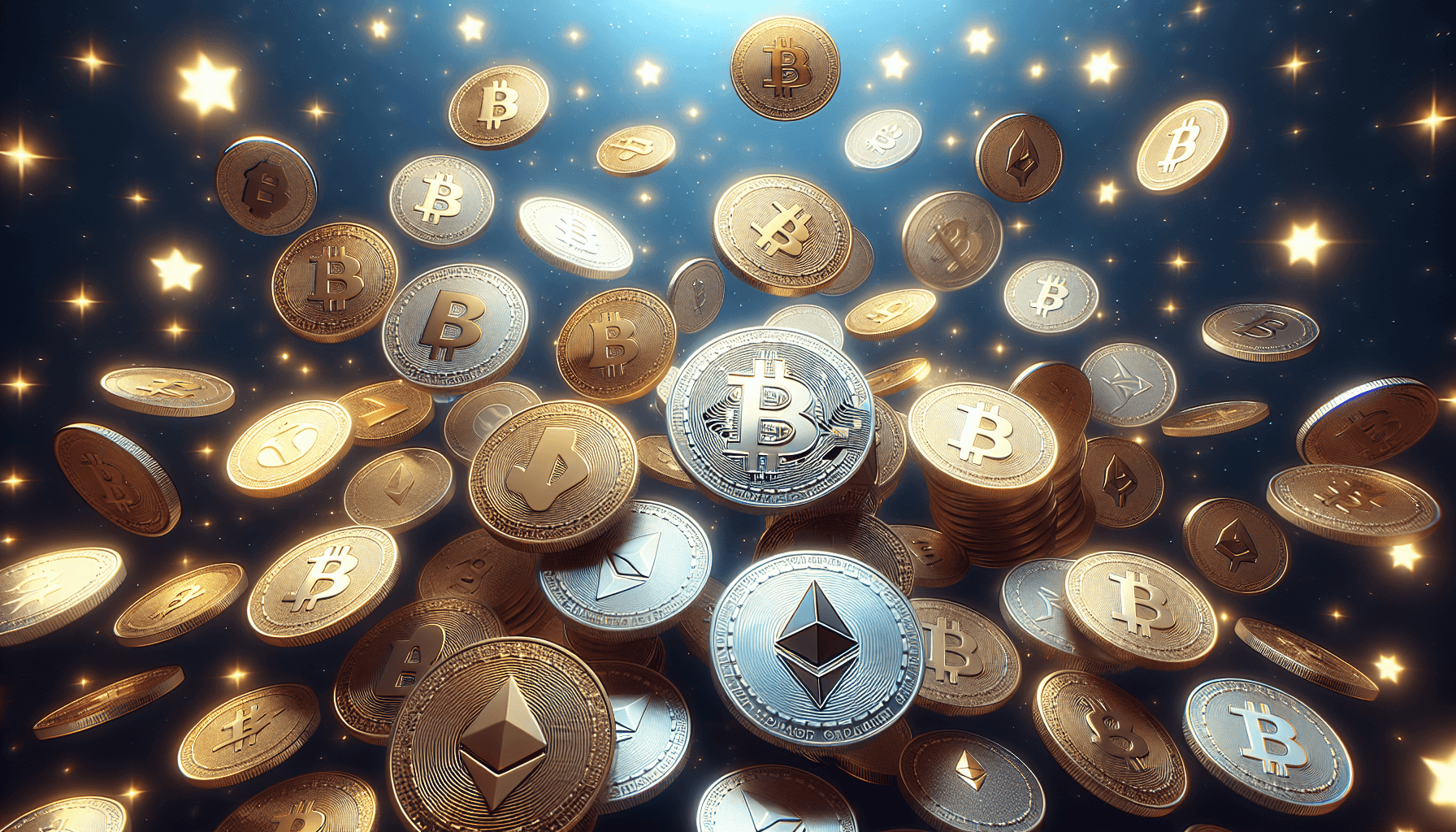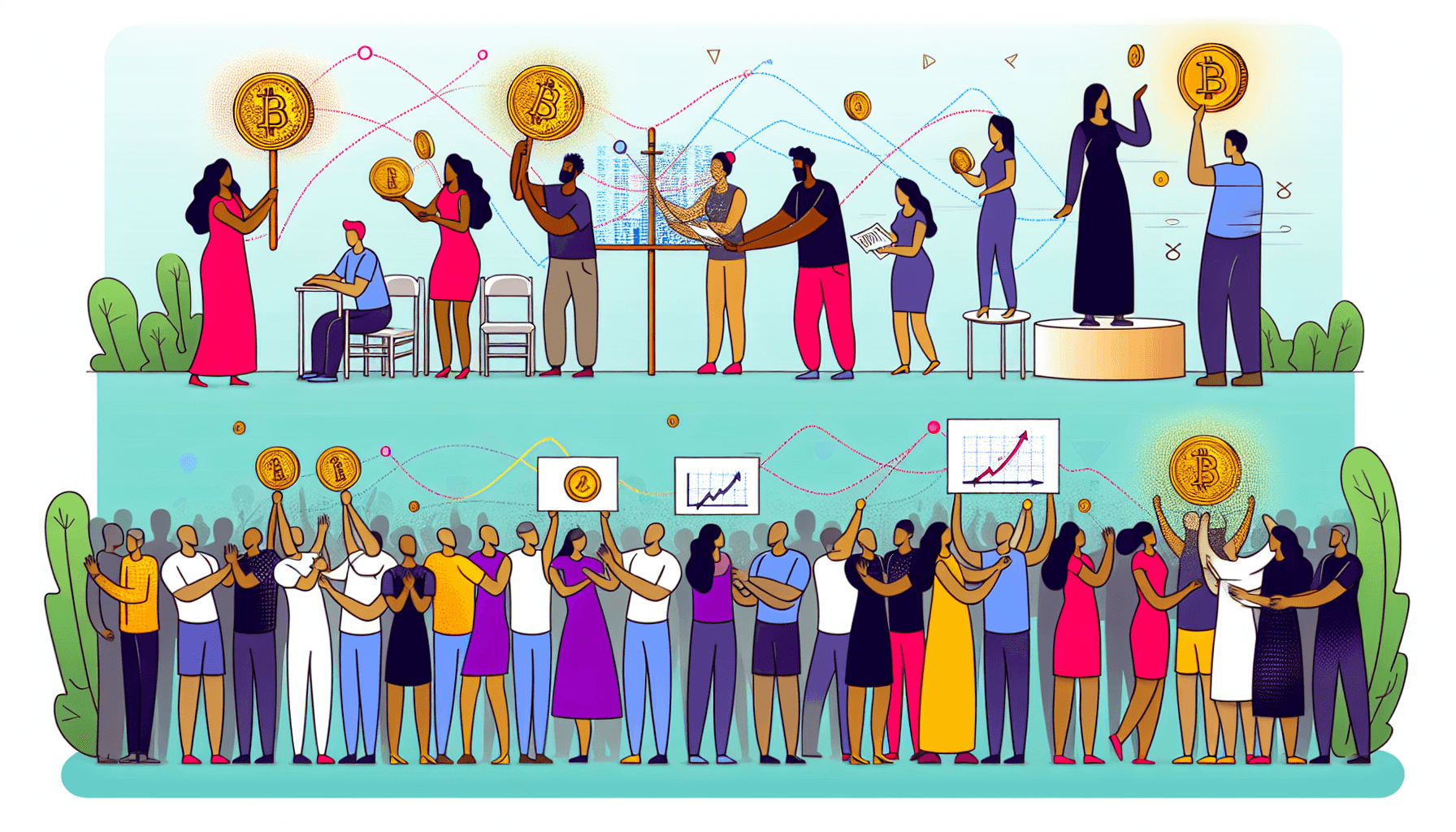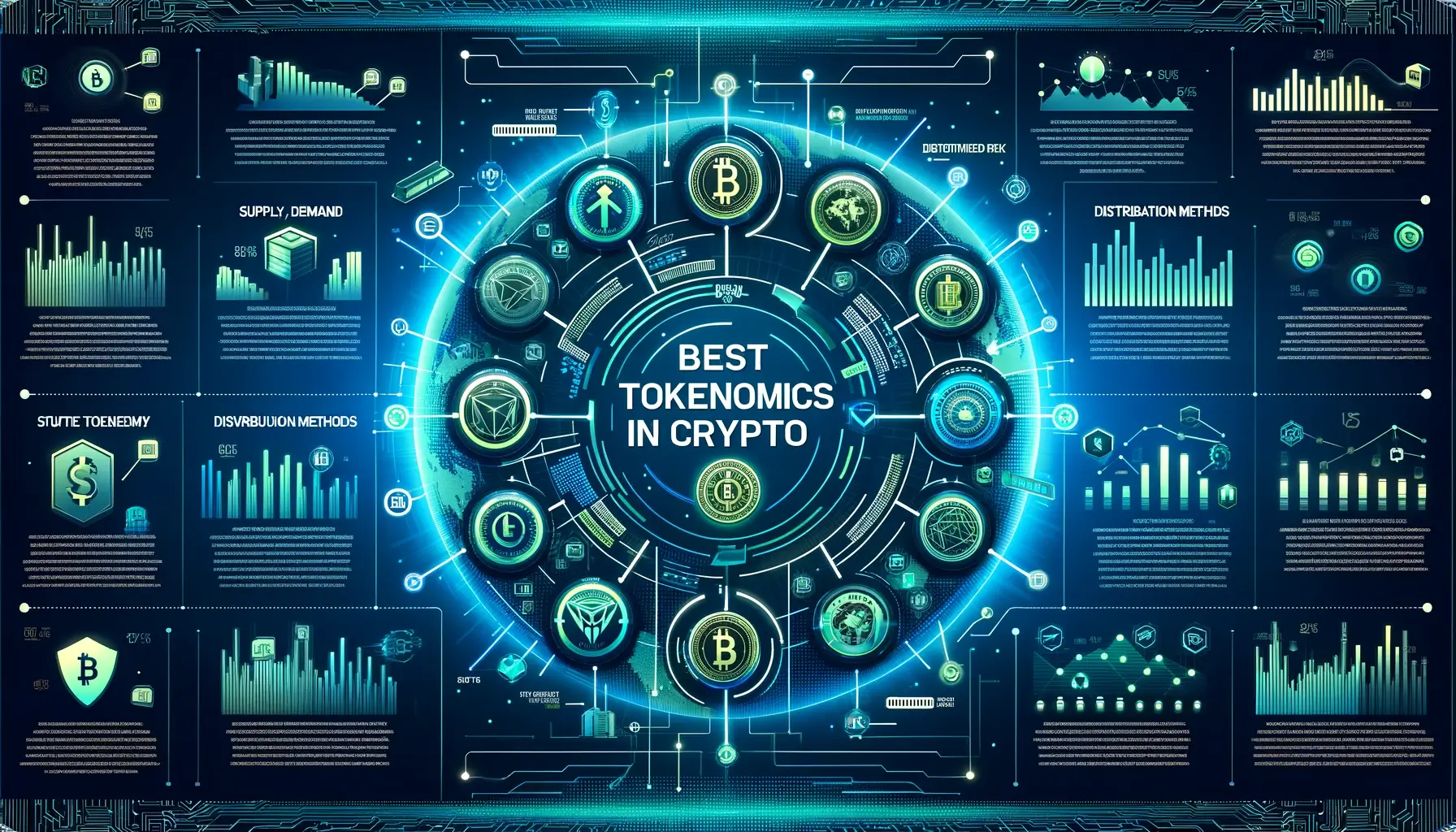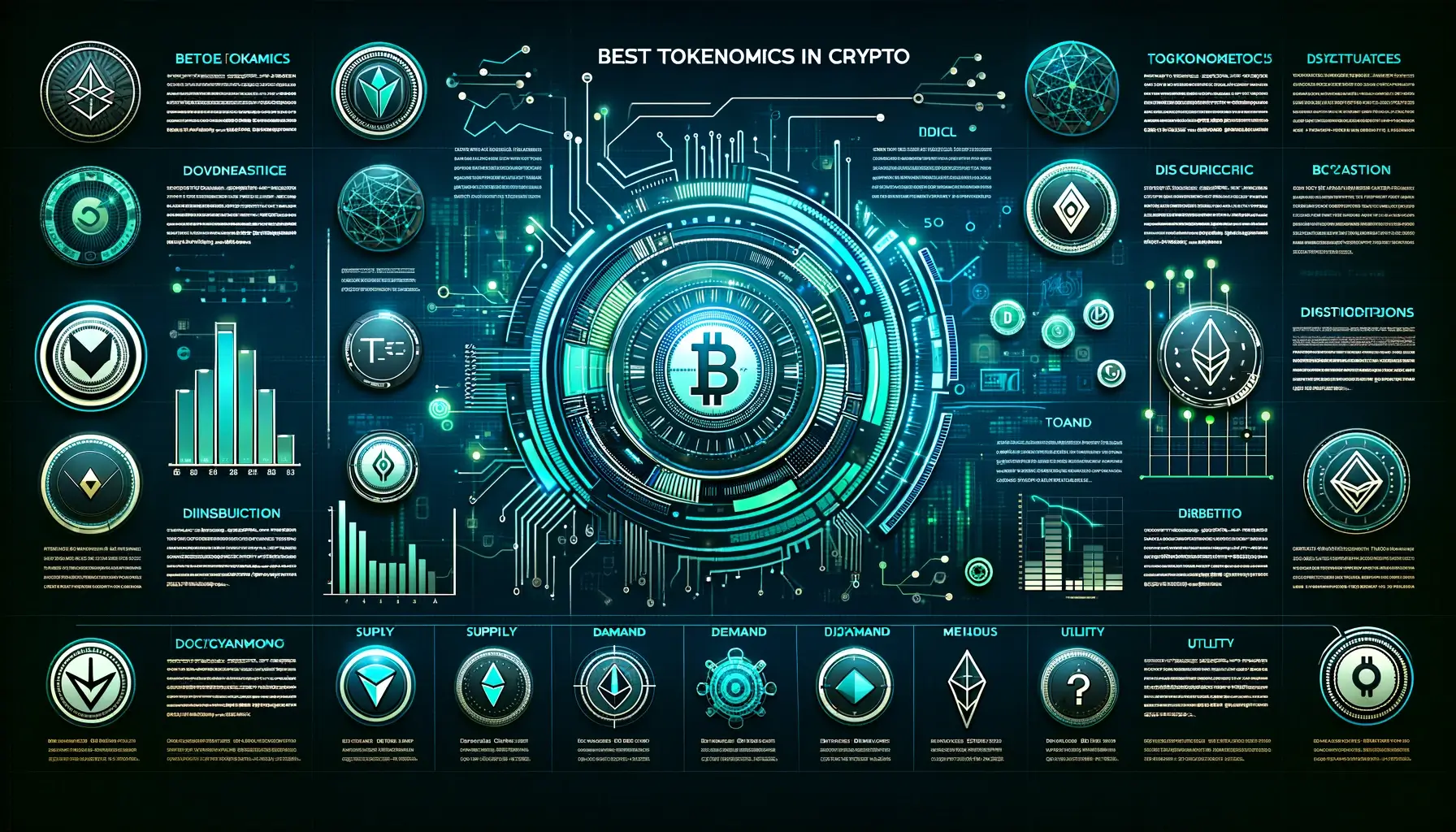Are you looking to understand which cryptocurrencies have the most substantial economic foundations? Our tokenomics crypto-list unpacks the supply, utility, and distribution mechanisms underpinning the market value of top digital currencies.
Simplifying this complex topic, we provide a clear, no-fluff guide to the tokenomics influencing today’s crypto investments and project trajectories.
Key Takeaways
- Tokenomics encompasses the economic framework of a crypto asset, detailing the supply and distribution mechanics, token utility, and the ecosystem’s incentive structure, all crucial for the asset’s market perception and long-term viability.
- Market capitalization, transaction fees, and governance tokens significantly influence a token’s value, with well-structured tokenomics leading to increased demand and potentially higher prices for the crypto asset.
- Token distribution plans must balance supply and demand. Token burns and smart contracts regulate supply while ensuring long-term project stability through strategic technical and marketing efforts.
Top 20 Best Tokenomics Crypto List
| Name | Symbol | Launch Year | Maximum Supply | Current Circulating Supply | Primary Use Case | Governance | Staking Rewards | Deflationary Mechanisms | Distribution Method |
|---|---|---|---|---|---|---|---|---|---|
| Bitcoin | BTC | 2009 | 21 Million | 19 Million | Digital Gold, Store of Value | No | No | Halving events reduces block rewards | Mining |
| Ethereum | ETH | 2015 | No Cap | 120 Million | Smart Contracts, DApps | Yes, via EIPs | Yes, with ETH 2.0 | EIP-1559 introduces a burn mechanism | Pre-sale & Mining |
| Binance Coin | BNB | 2017 | 200 Million (burn mechanism in place) | 150 Million | Exchange Utility, Transaction Fees | Yes | Yes, on Binance Chain | Quarterly burns until 50% of the supply is destroyed | ICO |
| Cardano | ADA | 2017 | 45 Billion | 32 Billion | Smart Contracts, DApps | Yes | Yes | No | ICO |
| Solana | SOL | 2020 | 489 Million | 300 Million | High-speed Blockchain, DApps | Yes | Yes | No | Sale |
| Polkadot | DOT | 2020 | No Cap | 1 Billion | Interoperability, Web3 | Yes | Yes | No | Sale |
| Chainlink | LINK | 2017 | 1 Billion | 450 Million | Oracle Networks | No | No | No | ICO |
| Ripple | XRP | 2012 | 100 Billion | 45 Billion | Payment Settlement, Remittance | No | No | No, but the escrowed supply release | Pre-mined |
| Litecoin | LTC | 2011 | 84 Million | 70 Million | Digital Silver, Transactional | No | No | Halving events reduces block rewards | Mining |
| Uniswap | UNI | 2020 | 1 Billion | 300 Million | Decentralized Exchange | Yes | Yes, liquidity provision | No | Airdrop to users & sale |
| Tezos | XTZ | 2018 | No Cap | 850 Million | Smart Contracts, Self-Amending Ledger | Yes | Yes | Inflationary with baking and endorsing rewards | ICO |
| Cosmos | ATOM | 2019 | No Cap | 210 Million | Interoperability, Custom Blockchains | Yes | Yes | Inflationary mechanism for staking rewards | Sale |
| Avalanche | AVAX | 2020 | 720 Million | 220 Million | High-throughput Blockchain, DApps | Yes | Yes | Fees are burned, reducing supply | Sale |
| Algorand | ALGO | 2019 | 10 Billion | 6 Billion | Speed, Efficiency, Finality | Yes | Yes | No, but rewards for participation | Auction |
| VeChain | VET | 2015 | 86.7 Billion | 64 Billion | Supply Chain Management | Yes | Yes | No | ICO |
| Terra (Classic) | LUNA (now LUNC) | 2018 | No Cap (after the crash) | Varies widely | Stablecoins, DeFi (before the crash) | Yes | Yes, pre-crash | Pre-crash mechanisms invalidated | ICO |
| Aave | AAVE | 2017 | 16 Million | 12 Million | Decentralized Lending | Yes | Yes, via staking | No | ICO |
| Monero | XMR | 2014 | No Cap (Tail Emission) | 18 Million | Privacy-focused Transactions | No | No | Tail emission for miner incentives | Mining |
| SushiSwap | SUSHI | 2020 | 250 Million | 190 Million | Decentralized Exchange, Automated Market Maker | Yes | Yes, liquidity provision | No | Airdrop & Sale |
| Filecoin | FIL | 2020 | 2 Billion | 100 Million | Decentralized Storage Network | Yes | Yes, via sealing and storage deals | No | ICO |
This expanded table provides a snapshot of the diversity in tokenomics across the cryptocurrency ecosystem, showcasing how different projects tailor their economic models to their specific use cases and goals.
Understanding these tokenomics factors is critical for potential investors, developers, and users, as they significantly impact each cryptocurrency’s utility, scarcity, and value proposition.
Deciphering Tokenomics: The Foundation of Crypto Assets

Tokenomics, also known as token economics, studies the supply and demand characteristics that make a cryptocurrency valuable and appealing to investors. It encompasses intricate details such as:
- supply and issuance
- utility
- incentives for holding
- the ecosystem surrounding a token
These factors contribute to the significance of a token’s issuance in the crypto world.
A comprehensive tokenomics model includes elements such as:
- Token distribution
- Utility
- Total supply
- Price stabilization mechanisms
These elements are foundational to a crypto asset’s blueprint. This makes tokenomics design critical to ensure a sustainable economic model, influencing a crypto token’s long-term supply and market distribution and affecting investor perception and project longevity.
Understanding Token Supply
Grasping the token’s total supply the total token supply is an integral part of tokenomics. It entails examining classifications such as:
- Circulating supply: the tokens currently available for trading
- Total supply: the total number of tokens that have been created
- Maximum supply: the maximum number of tokens that can ever exist
These classifications describe the stages and limitations of a token’s availability in the market. The maximum supply sets a hard cap on the number of tokens that can ever exist. In contrast, the current circulating supply reflects the amount of tokens available for trading. Both these aspects influence scarcity and value perceptions. I
investors thus evaluate the total and circulating supplies and the maximum token supply to assess market capitalization and project valuation, considering both current liquidity and future potential for price stability.
A transparent token distribution plan that separates circulating, total, and maximum supplies is crucial to maintaining trust with potential early investors and ensuring the project’s success at launch.
Token Distribution Mechanics
Token distribution, a significant component of a crypto project’s tokenomics, concerns the detailed allocation and fixed supply of tokens to various investor groups. This process encompasses several components:
- Allocation strategies
- Vesting schedules
- Distribution mechanisms
- Governance considerations
A fair token allocation usually reserves a smaller portion of the maximum supply of tokens for insiders, aiming to distribute the majority of tokens among a broad set of stakeholders.
For instance, Polkadot dedicated 58.4% of its tokens to public investors and allocated 30% more to its founders. Today’s token distribution landscape includes models like:
- Pre-sales
- Public sales
- Airdrops
- Mining
- Staking rewards
- Reserves for future use
- DAO governance incentives
Token Utility: Beyond Just Value
Moving beyond value, we should examine the token and utility tokens themselves – another fundamental aspect of tokenomics. Utility tokens, which are also referred to as Dapp or protocol tokens, are digital tokens.
These tokens give the holder the right to access or use a specific product or service within an ecosystem. Unlike security tokens that signify ownership or investment stakes, utility tokens are employed within networks to incentivize users through rewards or discounts when accessing the network’s services or paying transaction fees.
Ethereum’s gas token, used to pay transaction fees on its network, is a prime example of a utility token. Utility tokens play a vital role in the governance of decentralized exchanges, allowing holders to vote on pivotal decisions and thereby influencing fee structures and updates to network protocols.
Key Factors Shaping Token Price Dynamics

Understanding the basic concepts of tokenomics, we can now explore the dynamics influencing token prices. Market demand for a token, reflecting users’ and investors’ willingness to buy and hold, is a significant determinant of its price. Trading volume also plays a crucial role, contributing to fairer prices and indicating token price and volatility, which is pivotal for traders.
Governance tokens add value in decentralized exchanges by granting holders governance participation, potentially increasing the token’s attractiveness and price. Strong governance tokenomics incentivize token purchase and retention, increasing token demand and potentially higher token prices.
Market Capitalization and Its Significance
Market capitalization is a crucial measure representing the cumulative value of all mined coins. It is calculated by multiplying the current market price of one coin by the total number of mined coins. This metric helps investors understand the size and popularity of a cryptocurrency within the market.
A higher market cap or capitalization suggests more stability in a cryptocurrency, making it a potentially safer investment option. Investor sentiment and perceived value can be influenced by market cap, with higher caps often reflecting higher demand and stability.
The Influence of Transaction Fees on Token Value
Transaction fees can significantly influence a token’s value. High transaction fees can deter users from making transactions, potentially reducing the demand and value of a cryptocurrency. Conversely, low gas or reasonable transaction fees can encourage more transactions, supporting the demand for and value of more tokens in cryptocurrency.
Interestingly, cryptocurrency transactions can offer lower fees and faster processing times compared to some traditional banking transactions. Cryptocurrency transfer apps have gained popularity for saving financial companies time and money by eliminating bureaucratic red tape and reducing third-party fees.
In the grand scheme of tokenomics, low transaction costs and high transfer speeds are critical for the health of the ecosystem.
Governance Tokens: Power to the People
Governance tokens, as digital assets, grant their holders voting rights or decision-making authority over the evolution and operations of a blockchain network or decentralized platform. The involvement in governance afforded by these tokens signals a level of decentralization and can enhance investor confidence and incentivize active community engagement and participation.
Governance tokens can impact a project’s market capitalization by stoking investor confidence in the project’s perceived long-term viability. This can affect market demand, making the governance token more appealing and potentially increasing its price.
| Factor | Description | Impact on Price Dynamics |
|---|---|---|
| Market Demand and Supply | Basic economic principle: high demand and low supply increase prices, while high supply and low demand decrease them. | Direct correlation with price is the primary driver of short-term price changes. |
| Investor Sentiment and Psychology | Influenced by news, social media, and public perception. | High volatility can cause sharp price movements in either direction based on collective investor behavior. |
| Regulatory Environment | Legal frameworks and government regulations affecting cryptocurrencies. | Positive regulations can boost prices; negative regulations can lead to market sell-offs. |
| Technological Developments | Network upgrades, security enhancements, and new features. | Positive developments increase prices; technical failures can lead to price declines. |
| Adoption and Use Cases | Real-world applications and acceptance of the token. | Higher adoption usually leads to more stable and increased prices. |
| Macro-Economic Factors | Includes inflation, interest rates, and geopolitical events. | It can influence investor behavior; economic downturns might increase demand for cryptocurrencies. |
| Liquidity and Market Depth | The ease with which a token can be traded without affecting its price. | Higher liquidity results in lower volatility; low liquidity can cause drastic price changes. |
| Tokenomics and Supply Mechanisms | Economic model and supply characteristics, such as inflation and deflation mechanisms. | Deflationary models can lead to price appreciation; inflationary models might depress prices. |
| Market Manipulation | Activities by large holders or groups to manipulate prices. | It can cause artificial price surges or drops and increase market unpredictability. |
| External Partnerships | Collaborations and integrations with other companies or platforms. | It can boost token visibility and perceived value, potentially increasing prices. |
| Competing Technologies | The emergence of better or more efficient competing tokens. | Negative impact on prices of existing tokens if competitors offer superior technology or features. |
| Mining and Energy Costs | Costs associated with mining tokens, especially for proof-of-work models. | Higher costs might increase token prices due to the higher returns miners require. |
Exploring Prominent Crypto Tokens and Their Economics

With the expansion of the cryptocurrency landscape, numerous new tokens have emerged prominently, each exhibiting distinct tokenomics models. From Binance Coin (BNB) to Ethereum and DeFi tokens, it’s fascinating to delve into these diverse models and their impact on project success.
We should investigate these notable crypto tokens and their inherent economics.
Binance Coin (BNB): A Case Study
Binance Coin (BNB) pays transaction fees on the Binance platform and BNB Chain, encouraging users to hold and use the native token from within the ecosystem. BNB’s allocation strategies include trading fee discounts and token sales on the Binance Launchpad, which incentivize users to retain and use the token, increasing its utility and demand.
Before the launch of Binance Coin, Binance carefully planned its tokenomics, which included mechanisms like a burn schedule, setting the foundation for its subsequent growth and strong market capitalization.
Ethereum and It’s Evolving Tokenomics
Ethereum, one of the most renowned cryptocurrencies, has significantly evolved its tokenomics. Ethereum’s original network utilized a Proof of Work consensus mechanism, where new tokens were emitted through mining.
However, this is set to change with Ethereum’s upcoming transformation to a Proof of Stake consensus method, known as ‘The Merge.’ This shift aims to lower the token issuance rate and boost network efficiency.
Such evolution in token economics. Ethereum’s tokenomics, coupled with token-burning mechanisms like EIP-1559, is expected to establish a deflationary pressure where Ethereum could become a deflationary asset with reduced supply and incentives for long-term holding.
The Phenomenon of DeFi Tokens
Decentralized Finance (DeFi) tokens have emerged as a phenomenon in the crypto world. These tokens incentivize liquidity provision and user participation through yield farming, which rewards providers with additional tokens. Various DeFi platforms allow investors to earn rewards by:
- Staking or supplying cryptocurrency
- Participating in liquidity pools
- Providing collateral for loans
- Participating in governance activities
These platforms often achieve higher yields than traditional financial systems.
Token-based governance structures in DeFi projects enable token holders to actively influence the protocol’s development and future initiatives. However, it’s crucial to remember that smart contract security is paramount in DeFi token design, often requiring rigorous audits, bug bounties, and real-time monitoring to reduce risks.
Innovative Token Launch Methods

As the crypto ecosystem evolves, so do the new token launch strategies and methods. From initial coin offerings (ICOs) to auctions, crowdfunding, and fair distribution models, various methods exist to raise funds and establish the initial circulating supply for blockchain projects. Successful token distribution examples that have shaped the industry include:
- Bitcoin’s mining rewards
- Ethereum’s ICO
- Uniswap’s airdrop
- Compound’s liquidity mining
Conducting effective marketing for a token launch is vital as it communicates the project’s unique value proposition and the advantages of its tokenomics, thus increasing awareness and attracting users.
Initial Coin Offering (ICO) Revisited
The concept of Initial Coin Offerings (ICOs), where investors purchase the tokens in exchange for cryptocurrencies like Bitcoin or Ethereum, has been a popular method for token creation. However, the ICO model has faced scrutiny and regulatory challenges, necessitating its evolution.
As a result, more compliant fundraising methods, such as Security Token Offerings (STOs) and Initial Exchange Offerings (IEOs), have emerged as evolutions from the original ICO model.
These public sales on cryptocurrency exchanges offer broader access to tokens and provide liquidity but require careful consideration of exchange selection, compliance with regulations, and market surveillance.
Liquidity Mining and Yield Farming
Liquidity Mining and Yield Farming are innovative token launch methods that have gained traction in crypto. Liquidity mining is where users are incentivized to provide liquidity to decentralized exchanges by receiving token rewards, increasing a project’s liquidity.
Although a form of yield farming, liquidity mining specifically rewards liquidity providers with the platform’s coin and fee revenues.
Yield farming involves:
- Earning additional cryptocurrency by staking or lending existing crypto holdings in DeFi protocols
- Aiding in the spread of token ownership
- Incentivizing early adopters
NFTs and Their Unique Tokenomics
Non-fungible tokens (NFTs) have introduced a unique aspect to tokenomics, governing the creation, demand, and supply transactions of unique digital assets. Innovative token launch methods such as NFT mints have paved new ways for artists and collectors to interact with the digital token economy, with projects like CryptoPunks and Bored Apes Yacht Club leading the way.
NFT collections such as Bored Apes introduce tokenomic structures by incorporating utilities like Ape Coin, allowing for community voting and shared decision-making on future project developments.
Case studies like CryptoPunks, which gained early popularity, and Kaleidr, which promotes collaborative art through unique tokenomics, illustrate the diverse ways NFT projects influence market trends and community building.
| Method | Description | Advantages | Challenges | Examples |
|---|---|---|---|---|
| Fair Launches | No pre-mining or private sales; open to all participants equally. | Promotes fairness and reduces insider advantages. | Limited initial funding, potential for low initial liquidity. | Yearn Finance (YFI) |
| Initial DEX Offerings (IDOs) | Tokens launched on decentralized exchanges. | Immediate liquidity, accessible to retail investors, anti-whale mechanisms. | The potential for high volatility requires thorough vetting by DEX platforms. | Uniswap, PancakeSwap |
| Bonding Curves | Price increases along a mathematical curve with increasing supply. | It prevents sudden price spikes and encourages gradual investment. | Complex pricing models require user education on mechanics. | Balancer, Bancor |
| Token Auctions | Tokens distributed via auction (Dutch, English). | Market-driven pricing and fair distribution based on demand. | The risk of overpricing or underpricing may exclude smaller investors. | Polkadot (DOT) |
| Staking-Based Launches | New tokens are distributed to users who are staking existing tokens. | Rewards loyalty aligns incentives with long-term commitment. | Can centralize power among large stakeholders, potential for over-reliance on staked tokens. | Cosmos (ATOM), Ethereum 2.0 |
| Token Burning and Minting | Tokens are burned or minted based on predefined conditions. | Influences token scarcity and inflation can stabilize value. | Requires careful economic modeling to avoid negative effects on supply/demand. | Binance Coin (BNB), Shiba Inu (SHIB) |
| Airdrops and Retroactive Rewards | Free distribution of tokens to existing holders or active users. | Engages and rewards the community and promotes user retention and growth. | It can lead to sudden sell-offs and the potential for Sybil attacks to gain airdrops. | Uniswap (UNI), 1inch |
| Launchpads | Platforms offering infrastructure and support for token launches. | Provides compliance, marketing, and technical support; lowers entry barriers for new projects. | Participants often need to hold or stake the platform’s native token, leading to potential centralization. | Binance Launchpad, Polkastarter |
| Continuous Token Offerings (CTOs) | Tokens are continuously offered for sale over time. | Reduces pressure from single events and allows for stable accumulation. | Slow initial funding may not attract immediate interest or hype. | Reflexer (RAI) |
| Dual-Token Models | Two-token systems, often separating utility and governance functions. | Diversified use cases, potentially more stable ecosystems. | Complexity in understanding token roles, risk of value disparity between tokens. | MakerDAO (MKR/DAI), Terra (LUNA/UST) |
Balancing Act: Supply and Demand in Tokenomics

Tokenomics fundamentally involves balancing supply and demand. The initial token supply must be clearly defined and limited to prevent inflation and manage the perception of the token’s value at launch. On the other hand, strategic, technical, and marketing efforts are key drivers to increase the demand for a token.
Comprehending the implications of token supply metrics is vital for formulating a token distribution plan that can adjust to market conditions and project milestone fluctuations.
Token Burns and Their Market Impact
Token burns are designed to remove coins or tokens from circulation permanently. They are not included in the total supply and are intended to deflate the token’s value.
A ‘burn’ or ‘eater’ address is used to irreversibly destroy tokens, which can demonstrate a project owner’s commitment to reducing the supply and supporting the token’s value. By reducing the circulating supply, token burns can:
- Increase holders’ proportional ownership
- Enhance the utility of remaining tokens due to increased scarcity
- Raise the overall value for transactions, staking, or other platform features.
Token burns can be utilized as a market strategy to:
- Encourage price recovery and stability
- Foster engagement within the community
- Create user incentives by potentially increasing the value of token holdings.
Smart Contracts as Supply Regulators
In the realm of tokenomics, using smart contract functionality, contracts can serve as effective supply regulators. They can adjust a token’s supply in real time to trigger conditions like token velocity, total supply, and market price.
Smart contracts facilitate supply regulation through the automatic execution of token burns or fee collection when predefined conditions are met, impacting the token’s adequate supply. The supply adjustment processes are encoded in the blockchain using if/when-then logic and become irreversible upon execution.
The immutability of smart contracts ensures consistent application of supply mechanisms but raises concerns about inflexibility should the need for adjustment arise.
Risks and Rewards of Crypto Token Investments
Like any investment, putting money in crypto tokens carries risks and rewards. Investors grapple with various risks, including:
- Technical risks include securing private crypto storage and the possibility of loss due to forgotten keys, hardware failures, or cyberattacks.
- Market-related risks, such as high volatility and regulatory uncertainties, can lead to rapid price changes and affect market stability.
- Poorly designed tokenomics can lead to project failure.
- Factors such as unclear use cases, inflated supply, and non-compliance with regulations are potential red flags.
It is essential for investors to carefully consider these risks before investing in crypto tokens, which are a type of crypto asset.
However, crypto token investments also offer high return potential, although past performance does not always indicate future results, and there is a risk of total investment loss. Well-designed tokenomics are instrumental in the success of crypto projects and can attract significant investment.
Spotting Pump and Dump Schemes
Pump-and-dump schemes are a reality in the crypto world. Communication among pump and dump group members typically occurs on encrypted messaging services like Telegram. Promoters may use fear of missing out (FOMO) to urge potential buyers to act quickly.
Investment advice from celebrities or unverified social media sources should be treated with skepticism, as it may be part of a pump-and-dump scheme. Some key characteristics of pump and dump schemes include:
- Communication on encrypted messaging services
- Urging potential buyers to act quickly
- Use of fear of missing out (FOMO)
- Investment advice from celebrities or unverified social media sources
It is essential to be aware of these characteristics and exercise caution when investing in the crypto market.
To avoid falling victim to pump-and-dump schemes, it is advisable to steer clear of illiquid cryptocurrencies and verify sources of investment advice. Independent research and due diligence are crucial in making well-informed investment choices and avoiding pump-and-dump schemes.
Assessing Long-Term Viability
Assessing the long-term viability of a crypto token’s price is crucial in making informed investment decisions. Here are some factors to consider:
- Direct engagement with the cryptocurrency project’s team: This can help you gauge their professionalism and commitment to the project.
- Clarity of the use case: A clear and well-defined use case indicates that the project has a purpose and potential value.
- Transparency of the roadmap: A transparent roadmap shows that the project has a clear plan for development and growth.
- Active development team: An active and dedicated development team is a positive sign that the project is being actively worked on and improved.
- Community involvement: The cryptocurrency community plays a vital role in self-regulation by exposing fraudulent activities and assessing project credibility.
Considering these factors can help you determine the legitimacy and potential of a cryptocurrency project. Tokenomics is regarded as one of the most crucial aspects in evaluating a crypto project’s potential for success. Without sound tokenomics, even projects with innovative products and strong teams can struggle to gain traction.
| Aspect | Description |
|---|---|
| Rewards | |
| High Potential Returns | Crypto tokens, especially in emerging projects, can experience rapid price increases, offering investors significant short-term and long-term gains. |
| Diversification | Crypto tokens provide a unique asset class that can diversify an investment portfolio beyond traditional stocks and bonds, potentially reducing overall portfolio risk. |
| Access to Innovative Projects | Investing in crypto tokens can grant early access to innovative technologies and projects, such as decentralized finance (DeFi) platforms, NFTs, and blockchain utilities. |
| Liquidity | Many crypto tokens are traded on multiple exchanges, providing high liquidity and allowing investors to buy and sell tokens quickly. |
| Decentralization and Control | Investors can gain access to decentralized projects that are not controlled by any single entity, potentially reducing systemic risks associated with traditional finance. |
| Risks | |
| Volatility | Crypto markets are highly volatile, with prices often experiencing significant swings within short periods, leading to potentially large losses. |
| Regulatory Uncertainty | The regulatory environment for cryptocurrencies is evolving, and sudden regulatory changes can negatively impact token prices or lead to legal risks. |
| Security Risks | Crypto tokens are susceptible to hacking, fraud, and technical vulnerabilities, especially if stored on insecure exchanges or wallets. |
| Market Manipulation | Due to relatively low market capitalization and regulatory oversight, some tokens are prone to market manipulation and pump-and-dump schemes. |
| Lack of Fundamental Valuation | Unlike traditional assets, many crypto tokens lack fundamental metrics for valuation, making it difficult to assess their intrinsic value and leading to speculative bubbles. |
| Technology Risks | The underlying technology, such as blockchain or smart contracts, can have bugs or flaws that may lead to loss of funds or reduced functionality. |
| Scams and Fraud | The crypto space is notorious for scams, fraudulent Initial Coin Offerings (ICOs), and rug pulls, where project developers vanish with investor funds. |
| Limited Historical Data | As a relatively new asset class, cryptocurrencies have limited historical data, making it difficult to predict long-term trends and risks. |
| Tax Implications | Crypto investments may have complex tax implications that vary by jurisdiction, potentially leading to unexpected tax liabilities or legal issues. |
Maximizing Token Utility: Real-World Applications
Tokens’ utility transcends the boundaries of the crypto ecosystem and has applications in the real world. NBA Top Shot, created in partnership with Dapper Labs and the NBA, has revolutionized the collection and trading of basketball-related digital media through decentralized exchanges or NFTs.
OpenSea operates as one of the predominant NFT marketplaces, hosting various digital assets such as art, collectibles, and gaming items for users to trade.
Qiibee has implemented a blockchain-based loyalty program, allowing businesses to reward customers with brand-specific tokens. Starbucks leverages blockchain for its loyalty program, offering a more secure, transparent way to earn and track rewards.
Digital Tokens in Action
Digital tokens in action provide a glimpse into their real-world utility. BNB holders, for instance, benefit from staking and earning passive income, along with other rewards like airdrops and exclusive promotions, fostering user engagement with the platform. UNI tokens facilitate governance by allowing stakeholders to participate in protocol development and enable holders to earn rewards from trading fees.
The accessibility of BNB and other cryptocurrencies enables a global user base and inclusivity, particularly for those lacking traditional banking services. Steemit enhances user retention and engagement by rewarding community members with cryptocurrency tokens for content creation and platform involvement.
From Gaming to Governance: Tokens Allocated for Diverse Uses
Tokens find a wide range of applications, from gaming to governance. Yuga Labs’ Bored Apes collection introduces Ape Coin as a local currency to distribute tokens that provide community value and voting power on project decisions. NFT tokenomics attach social value to tokens, leading to community benefits from token code, including exclusive social events and unique experiences.
Smart contracts automate HR processes such as onboarding and payroll, affecting the distribution and supply of tokens within corporate ecosystems. Users can use learning programs on crypto platforms to earn cryptocurrency, enhance their knowledge, and gain rewards.
Blockchain-based loyalty programs facilitate the creation of flexible coalition programs, transforming loyalty points into digital assets exchangeable within a market-like ecosystem.
Crafting Your Own Tokenomics Model: A Guide for Creators
For creators keen on starting their crypto projects, grasping tokenomics is the initial crucial step. Comprehending the token’s utility, business logic, properties, and use cases is vital for identifying the central utility and functionality of the token within its ecosystem. To avoid pitfalls in token design, token creators should:
- Clearly define use cases
- Maintain a balanced token supply
- Allocate tokens to key stakeholders
- Build a viable economy
- Design a token-burning mechanism
- Comply with regulations
- Align tokenomics with project milestones.
The Role of Initial Token Supply in Project Launch
The initial token supply is critical in forming the early market perception of a new crypto project. Some key strategies used to manage and distribute the initial supply of tokens to the market include:
- ICO (Initial Coin Offering)
- ITO (Initial Token Offering)
- IDO (Initial DEX Offering)
- Mining
- Staking
- Airdrops
- Bounty programs
Implementing token lockups and vesting periods is crucial for preventing early token holders from dumping their tokens, which helps align long-term interests and sustain initial market confidence.

Building a Sustainable Token Distribution Plan
Constructing a sustainable token distribution plan is a crucial element of developing a successful tokenomics model. A token distribution plan should thoroughly evaluate the following:
- Token utility
- The target audience
- Vesting schedules
- Legal aspects
- Prevailing market conditions
To ensure the project’s effectiveness and sustainability, incorporating token lockups and vesting schedules is vital for maintaining the long-term commitment of the core team and early investors, which underpins the stability of the token market.
Allocating token reserves for development, marketing, and ecosystem growth is necessary to finance ongoing improvements and partnerships and support the project’s long-term viability. The token distribution scheme must be designed to be adaptable to future project activities, such as enabling new token generation via mining or the maximum token supply and allocations via staking.
Building transparency and fairness into the token distribution process is critical to establishing trust and engendering a robust, active ecosystem for the crypto project. Here are some strategies to consider:
- Strategic partnerships: Allocate tokens in exchange for critical resources, knowledge, and market access from strategic partners. This can help propel the project forward.
- Investor relations: Allocate tokens to investors who can provide valuable support and guidance to the project.
- Community engagement: Engage the community through token allocation and governance mechanisms. This allows community members to contribute and participate actively in project-related decision-making processes.
By implementing these strategies, you can ensure a transparent and fair token distribution process that fosters trust and encourages active participation in the project.
| Aspect | Description | Considerations |
|---|---|---|
| 1. Token Purpose | Defines the primary function or utility of the token within the ecosystem. | – Is it a utility token, governance token, or security token? – What value does it provide to users? – Does it incentivize specific behaviors? |
| 2. Token Supply | Total number of tokens that will be created, including the initial supply and future issuance. | – Fixed supply vs. inflationary model. – Minting schedule and mechanism. – Deflationary mechanisms (e.g., token burning). |
| 3. Distribution Strategy | The plan allocates the initial supply of tokens to stakeholders, such as team members, investors, the community, and partnerships. | – Fair launch vs. pre-mine. – Vesting schedules for team and investors. – Community incentives and airdrops. |
| 4. Utility and Use Cases | Practical applications of the token within the ecosystem, such as payments, staking, governance, or access to services. | – How does the token drive demand? – Are there mechanisms for staking or locking tokens? – How does token utility impact token value and velocity? |
| 5. Governance Mechanism | How decisions are made regarding changes to the protocol or ecosystem, often involving token holders’ voting rights. | – On-chain vs. off-chain governance. – Voting power distribution among token holders. – Mechanisms to prevent governance attacks (e.g., vote buying, centralization). |
| 6. Incentive Structures | Rewards and penalties align participants’ behavior with the network’s goals, such as staking rewards, slashing penalties, or yield farming. | – What incentives drive positive behaviors (e.g., staking rewards)? – Are malicious activities penalized (e.g., slashing in proof-of-stake networks)? |
| 7. Economic Design | The economic principles governing token issuance, circulation, and pricing include demand-supply dynamics, market-making strategies, and liquidity management. | – How will the token maintain a stable value or grow in value? – Role of market makers and liquidity pools. – Mechanisms for controlling inflation or deflation. |
| 8. Security and Compliance | Ensuring the tokenomics model adheres to legal and regulatory frameworks while protecting against vulnerabilities and attacks. | – Compliance with securities laws and regulations. – Auditing smart contracts for security. – Implementing anti-money laundering (AML) and know-your-customer (KYC) policies. |
| 9. Sustainability and Growth | Strategies to ensure the long-term viability and scalability of the token and its ecosystem, including ecosystem fund management and partnerships. | – Is there a treasury or reserve fund? – Partnerships and ecosystem development strategies. – Roadmap for future growth and adaptability to market changes. |
| 10. Market Positioning | Defining the token’s unique value proposition and competitive advantage in the marketplace, considering factors like network effects, brand, and community engagement. | – How does the token stand out from competitors? – Strategies for community building and engagement. – Marketing and branding approaches. |
Summarization
In conclusion, tokenomics is a complex yet fascinating field underpinning the cryptocurrency ecosystem’s economic framework. From understanding token supply and distribution to exploring the dynamics that shape token prices, tokenomics is vast and multi-faceted.
As the crypto landscape continues to evolve, so do the models and strategies of tokenomics – from the tokenomics of prominent crypto tokens to innovative token launch methods and the balancing act of supply and demand.
While investing in crypto tokens comes with risks, it also offers potential rewards in the growing digital asset and currency landscape. Whether you’re a creator looking to launch a new crypto project or an investor seeking to maximize token utility, understanding tokenomics is a crucial first step on your crypto journey.
Frequently Asked Questions
What crypto has the best tokenomics?
It’s difficult to determine the best crypto for tokenomics without specific information or context.
Where can I find tokenomics?
You can find tokenomics by navigating Coinbase Prices and selecting or searching for a cryptocurrency. Once you have chosen a cryptocurrency, market capitalization, and token supply information will appear below the price graph.
Which crypto can give 1000x in 2024?
It’s important to approach such investment claims cautiously, as they often come with high risk. Popular cryptocurrencies like Solana and Arbitrum are frequently mentioned as having the potential for significant growth in the crypto market in 2024.
Which coin will boom in 2024?
Ethereum (ETH) seems positioned for significant growth in 2024 due to its driving Web 3.0 innovation and being the preferred platform for decentralized applications and NFT projects.
What is tokenomics, and why is it important?
Understanding tokenomics is crucial as it directly impacts the success and sustainability of a cryptocurrency project, influencing investor perception and market distribution.
Disclaimer: The content on this site should not be considered investment advice. Investing is speculative. When investing, your capital is at risk.







